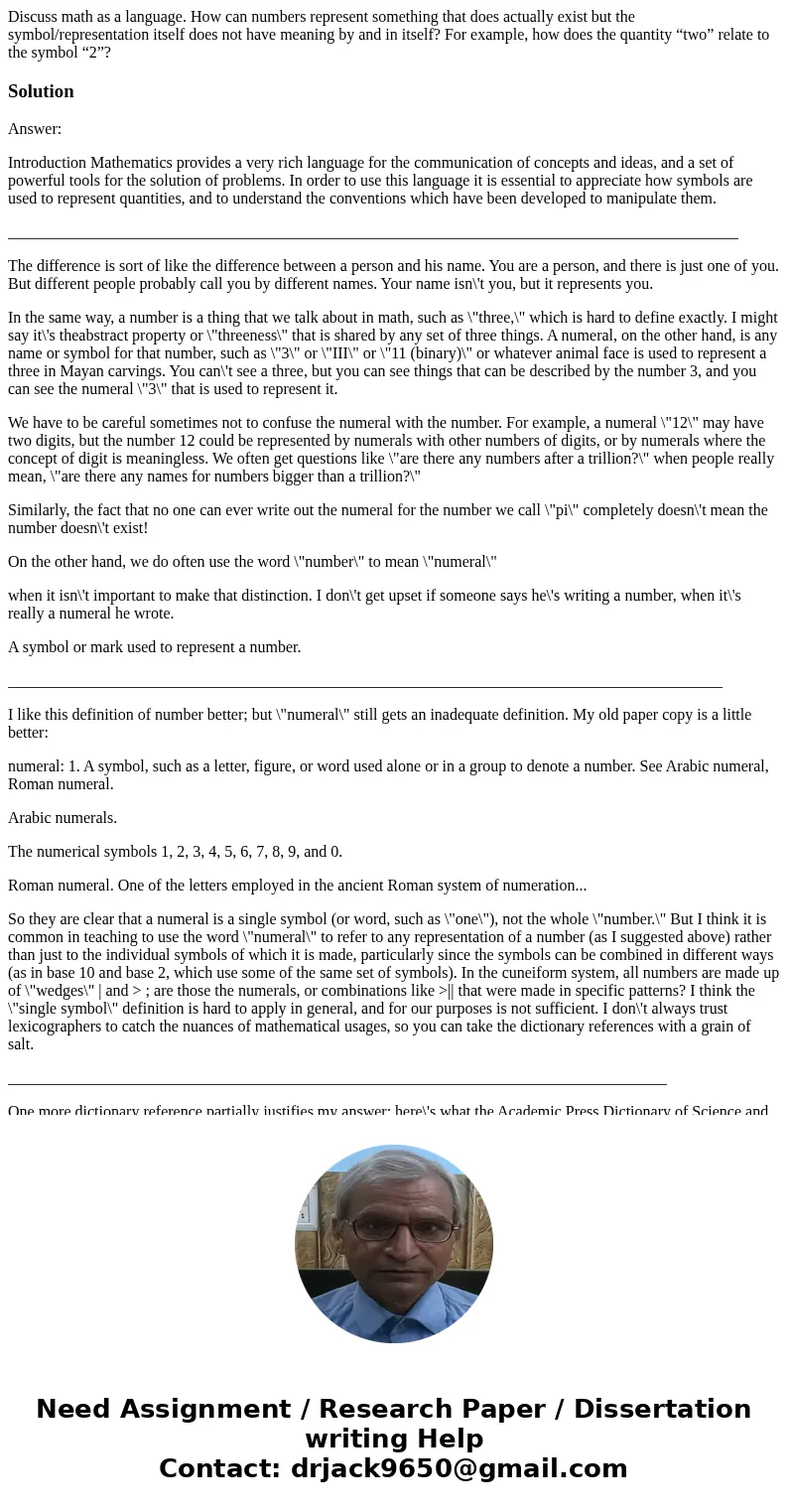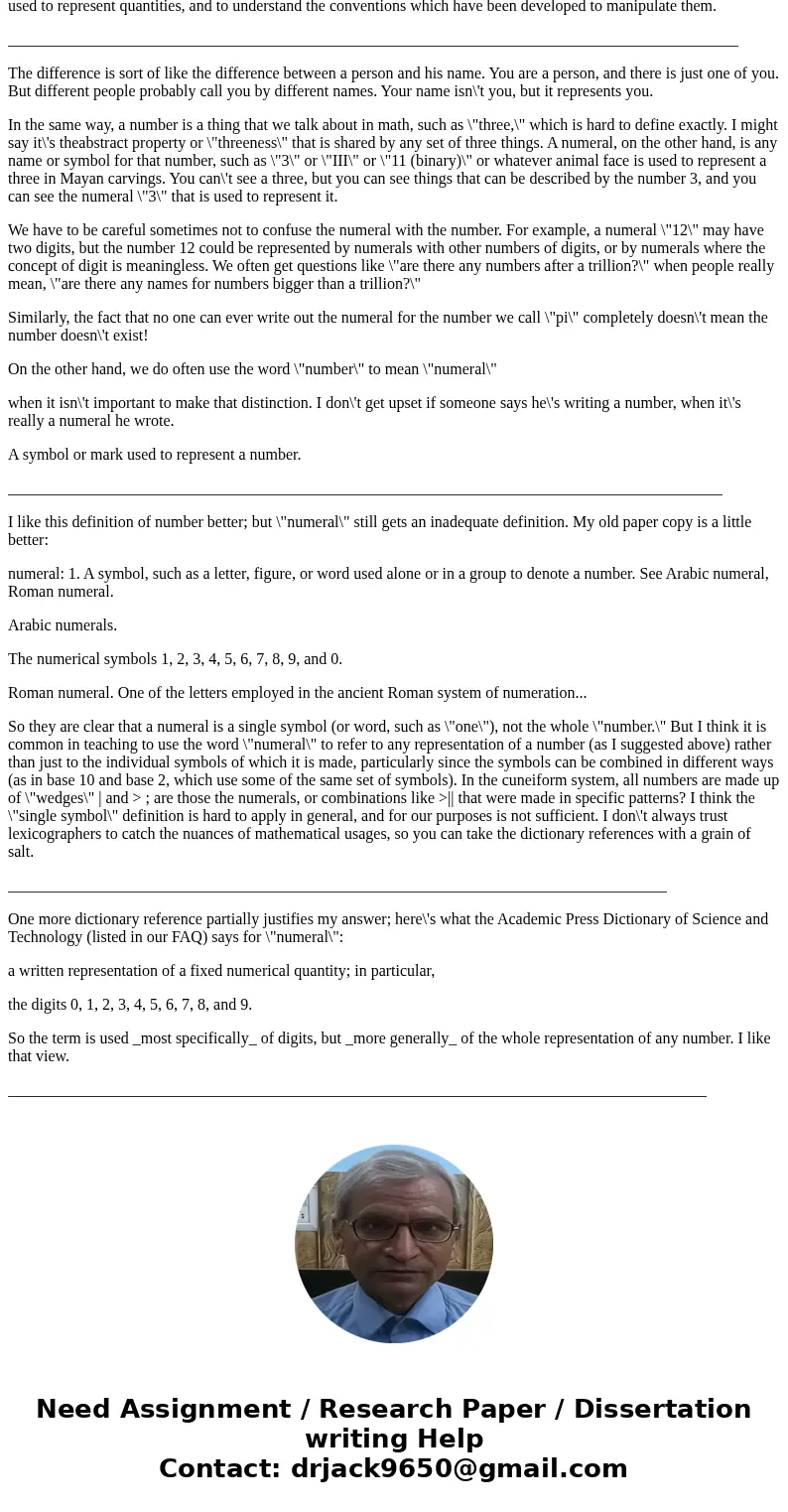Discuss math as a language How can numbers represent somethi
Discuss math as a language. How can numbers represent something that does actually exist but the symbol/representation itself does not have meaning by and in itself? For example, how does the quantity “two” relate to the symbol “2”?
Solution
Answer:
Introduction Mathematics provides a very rich language for the communication of concepts and ideas, and a set of powerful tools for the solution of problems. In order to use this language it is essential to appreciate how symbols are used to represent quantities, and to understand the conventions which have been developed to manipulate them.
____________________________________________________________________________________________
The difference is sort of like the difference between a person and his name. You are a person, and there is just one of you. But different people probably call you by different names. Your name isn\'t you, but it represents you.
In the same way, a number is a thing that we talk about in math, such as \"three,\" which is hard to define exactly. I might say it\'s theabstract property or \"threeness\" that is shared by any set of three things. A numeral, on the other hand, is any name or symbol for that number, such as \"3\" or \"III\" or \"11 (binary)\" or whatever animal face is used to represent a three in Mayan carvings. You can\'t see a three, but you can see things that can be described by the number 3, and you can see the numeral \"3\" that is used to represent it.
We have to be careful sometimes not to confuse the numeral with the number. For example, a numeral \"12\" may have two digits, but the number 12 could be represented by numerals with other numbers of digits, or by numerals where the concept of digit is meaningless. We often get questions like \"are there any numbers after a trillion?\" when people really mean, \"are there any names for numbers bigger than a trillion?\"
Similarly, the fact that no one can ever write out the numeral for the number we call \"pi\" completely doesn\'t mean the number doesn\'t exist!
On the other hand, we do often use the word \"number\" to mean \"numeral\"
when it isn\'t important to make that distinction. I don\'t get upset if someone says he\'s writing a number, when it\'s really a numeral he wrote.
A symbol or mark used to represent a number.
__________________________________________________________________________________________
I like this definition of number better; but \"numeral\" still gets an inadequate definition. My old paper copy is a little better:
numeral: 1. A symbol, such as a letter, figure, or word used alone or in a group to denote a number. See Arabic numeral, Roman numeral.
Arabic numerals.
The numerical symbols 1, 2, 3, 4, 5, 6, 7, 8, 9, and 0.
Roman numeral. One of the letters employed in the ancient Roman system of numeration...
So they are clear that a numeral is a single symbol (or word, such as \"one\"), not the whole \"number.\" But I think it is common in teaching to use the word \"numeral\" to refer to any representation of a number (as I suggested above) rather than just to the individual symbols of which it is made, particularly since the symbols can be combined in different ways (as in base 10 and base 2, which use some of the same set of symbols). In the cuneiform system, all numbers are made up of \"wedges\" | and > ; are those the numerals, or combinations like >|| that were made in specific patterns? I think the \"single symbol\" definition is hard to apply in general, and for our purposes is not sufficient. I don\'t always trust lexicographers to catch the nuances of mathematical usages, so you can take the dictionary references with a grain of salt.
___________________________________________________________________________________
One more dictionary reference partially justifies my answer; here\'s what the Academic Press Dictionary of Science and Technology (listed in our FAQ) says for \"numeral\":
a written representation of a fixed numerical quantity; in particular,
the digits 0, 1, 2, 3, 4, 5, 6, 7, 8, and 9.
So the term is used _most specifically_ of digits, but _more generally_ of the whole representation of any number. I like that view.
________________________________________________________________________________________


 Homework Sourse
Homework Sourse